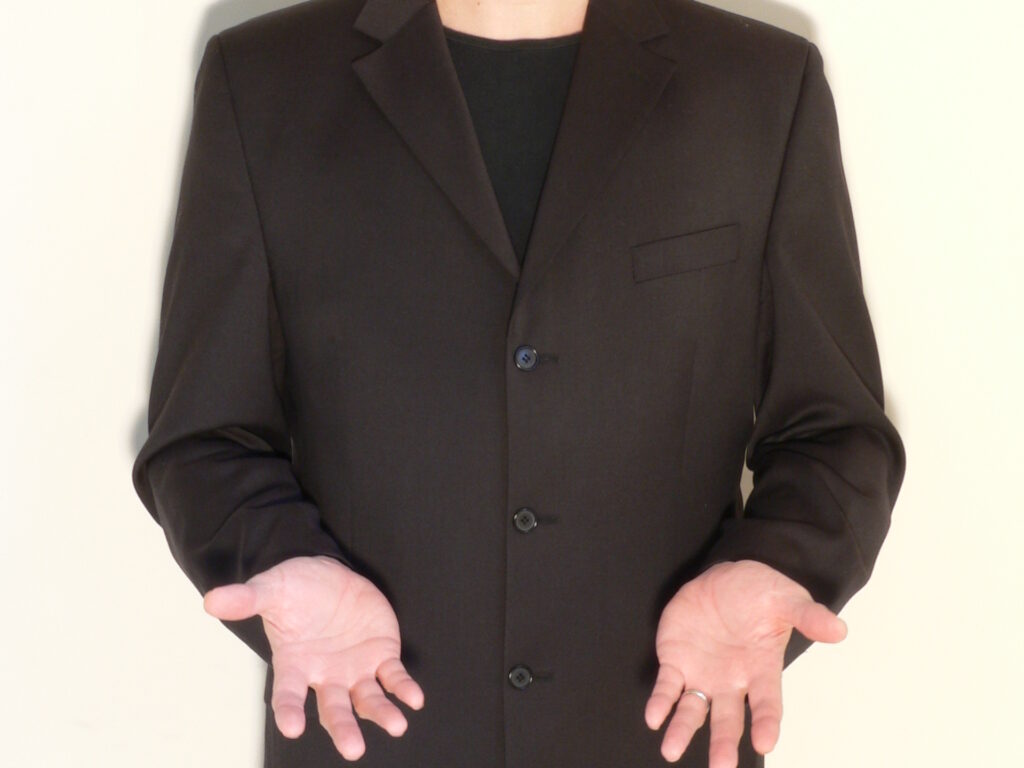Peter Clayton answers some questions from the community regarding body language.
I have received a number of frequently asked questions in the last month and I will do my best to answer them. If you have questions of your own with regard to body language in a business or training environment please let me know and I will include the answers in my next article.
Question: "Does body language change over time (as children, teenagers and then adults) when trying to conceal something?"

Children
If only were we were all as easy to read as children are. They express their feelings in a very open and obvious way. They don’t hold anything back which means their gestures are bigger, more expressive and are therefore easier to read.
Teenagers
Teenagers quickly become aware that it requires some stealth in order to do the things that grown-ups do and get away with them. However, they soon discover that they are not having as much success as they would like, because adults can tell if they are concealing something. So teenagers then swiftly adopt diversion tactics to avoid being put on the spot, and answer an awkward question with a question, such as:
- What makes you think it was me?
- Who told you that?
- Did he/she say I was there?
- What’s up? Don’t you trust me?

Teenage body language
Unlike adults who display smaller more discrete signals, when teenagers feel awkward, they don’t just look down with their eyes when attempting to conceal something, they tilt their heads down as well. I have seen the odd example when you cannot see a teenager’s eyes any more because the head is tilted so much.
Where an adult might delicately touch the base of the nose, or just above the eye, or by the side of the nose when they feel awkward, the teenager will almost cover their mouth with their hand. At the same time their voice will drop in volume in the hope that you can’t tell whether they are telling you everything that happened or not.
Teenagers usually develop an easy to spot "tell". It might be a direction that the eyes follow, the way they adjust their hair, rub their neck or move awkwardly. Typically there are dozens of tells but most teenagers have just one or two and they are easy to spot and get used to.
When our girls were teenagers they both had different tells (they still do). It allowed me to judge whether what they were concealing was a serious problem that needed discussion or something that I could let slide. Whilst I have referred to teenagers here, they carry this body language into their early 20s, sometimes longer.

Adults
Adult body language causes the most concern because the gestures are much smaller, delicate and quicker. They are more refined and they look polite. Most of the gestures seem part of everyday life. To be able to read them accurately and consistently takes some practice.
I mentioned that the teenager would almost cover their mouth when discussing something awkward, whereas an adult might casually rub the base or side of the nose and you might be unaware of the significance of this.
You may have noticed yourself that when you are in a conversation that is making you feel uncomfortable you actually feel quite warm, possibly feel that your face may look red, even though it doesn’t. (Why not study your own body language for a few days and see what happens?)
What happens is, the skin gets warmer when we feel awkward because blood vessels in and around the nose, face, ears and neck are irritated when we are thinking one thing but saying another.
Most of us don’t want to conceal things and so when we do we feel slightly awkward. Most of the time it may be something simple or confidential. Either way, the skin feels slightly irritated and the only way to make the irritation to go away is to rub or lightly touch the tingling and offending areas of the face.
We have carried out a number of body language experiments in this area and discovered that most people observing hand-to-face contact thought that something was wrong and they became cautious of what was being said.
In conclusion, children are wonderful and tell you what they are thinking and what they want and are very expressive. Teenagers are also easy to read, although they employ diversionary tactics to try to deflect awkward questions. Watching my own children grow up was marvellous and because I understood them I could let them get away with most things (but not everything).
However, adults in business are a different thing. Whilst it takes some time to learn all the body language gestures and micro gestures, the main thing is to look for a cluster. It’s far more reliable and easier to see.
Cluster example
Two people are talking and one folds their arms and moves very gently away. At the same time eye contact drops by 10 or 20% and the person who has moved away speaks with a quieter voice than before and uses shorter sentences.
It would be fair to draw the conclusion that there was something wrong here. When several pieces of body language happen simultaneously it is a cluster. The arms folded, the small movement away, eyes that drop and the quieter voice all form a body language cluster, and in this case show that there is something wrong.
So yes, body language does change over time. Gestures become smaller, more discreet but they are still the same gestures. More refined, yes, but the same gestures. Life would be much easier if we didn’t grow up. (Although it might put me out of business.)
- Send your FAQs to Peter and he will endeavour to include them in future articles. Email your question here.
Peter Clayton answers some questions from the community regarding body language.
I have received a number of frequently asked questions in the last month and I will do my best to answer them. If you have questions of your own with regard to body language in a business or training environment please let me know and I will include the answers in my next article.
Question: "Does body language change over time (as children, teenagers and then adults) when trying to conceal something?"

Children
If only were we were all as easy to read as children are. They express their feelings in a very open and obvious way. They don't hold anything back which means their gestures are bigger, more expressive and are therefore easier to read.
Teenagers
Teenagers quickly become aware that it requires some stealth in order to do the things that grown-ups do and get away with them. However, they soon discover that they are not having as much success as they would like, because adults can tell if they are concealing something. So teenagers then swiftly adopt diversion tactics to avoid being put on the spot, and answer an awkward question with a question, such as:
- What makes you think it was me?
- Who told you that?
- Did he/she say I was there?
- What's up? Don't you trust me?

Teenage body language
Unlike adults who display smaller more discrete signals, when teenagers feel awkward, they don't just look down with their eyes when attempting to conceal something, they tilt their heads down as well. I have seen the odd example when you cannot see a teenager’s eyes any more because the head is tilted so much.
Where an adult might delicately touch the base of the nose, or just above the eye, or by the side of the nose when they feel awkward, the teenager will almost cover their mouth with their hand. At the same time their voice will drop in volume in the hope that you can't tell whether they are telling you everything that happened or not.
Teenagers usually develop an easy to spot "tell". It might be a direction that the eyes follow, the way they adjust their hair, rub their neck or move awkwardly. Typically there are dozens of tells but most teenagers have just one or two and they are easy to spot and get used to.
When our girls were teenagers they both had different tells (they still do). It allowed me to judge whether what they were concealing was a serious problem that needed discussion or something that I could let slide. Whilst I have referred to teenagers here, they carry this body language into their early 20s, sometimes longer.

Adults
Adult body language causes the most concern because the gestures are much smaller, delicate and quicker. They are more refined and they look polite. Most of the gestures seem part of everyday life. To be able to read them accurately and consistently takes some practice.
I mentioned that the teenager would almost cover their mouth when discussing something awkward, whereas an adult might casually rub the base or side of the nose and you might be unaware of the significance of this.
You may have noticed yourself that when you are in a conversation that is making you feel uncomfortable you actually feel quite warm, possibly feel that your face may look red, even though it doesn’t. (Why not study your own body language for a few days and see what happens?)
What happens is, the skin gets warmer when we feel awkward because blood vessels in and around the nose, face, ears and neck are irritated when we are thinking one thing but saying another.
Most of us don't want to conceal things and so when we do we feel slightly awkward. Most of the time it may be something simple or confidential. Either way, the skin feels slightly irritated and the only way to make the irritation to go away is to rub or lightly touch the tingling and offending areas of the face.
We have carried out a number of body language experiments in this area and discovered that most people observing hand-to-face contact thought that something was wrong and they became cautious of what was being said.
In conclusion, children are wonderful and tell you what they are thinking and what they want and are very expressive. Teenagers are also easy to read, although they employ diversionary tactics to try to deflect awkward questions. Watching my own children grow up was marvellous and because I understood them I could let them get away with most things (but not everything).
However, adults in business are a different thing. Whilst it takes some time to learn all the body language gestures and micro gestures, the main thing is to look for a cluster. It's far more reliable and easier to see.
Cluster example
Two people are talking and one folds their arms and moves very gently away. At the same time eye contact drops by 10 or 20% and the person who has moved away speaks with a quieter voice than before and uses shorter sentences.
It would be fair to draw the conclusion that there was something wrong here. When several pieces of body language happen simultaneously it is a cluster. The arms folded, the small movement away, eyes that drop and the quieter voice all form a body language cluster, and in this case show that there is something wrong.
So yes, body language does change over time. Gestures become smaller, more discreet but they are still the same gestures. More refined, yes, but the same gestures. Life would be much easier if we didn't grow up. (Although it might put me out of business.)
- Send your FAQs to Peter and he will endeavour to include them in future articles. Email your question here.




